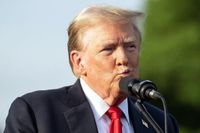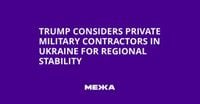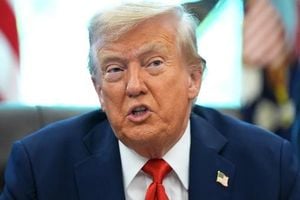In a move that could redefine the West’s involvement in Ukraine, U.S. President Donald Trump is negotiating with European allies to send American private military contractors to Ukraine as part of a sweeping new security framework, multiple sources told The Telegraph and other outlets on August 30, 2025. The plan, if realized, would sidestep Trump’s campaign promise not to deploy regular U.S. troops to Ukraine, while still signaling an unmistakable American commitment to Ukraine’s defense and regional stability.
The proposal, as described by European officials and reported by The Telegraph, forms a central pillar of a broader European-led security initiative. This framework encompasses thousands of troops, air policing missions, and naval operations in the Black Sea—all of which, officials say, are impossible without American intelligence, logistics, and command support. Final details could be announced as soon as this weekend, with Ukrainian President Volodymyr Zelenskyy indicating that specifics are imminent.
American contractors, under the plan, would be tasked with rebuilding Ukraine’s front-line defenses and constructing new military bases using methods honed during the wars in Iraq and Afghanistan. “The principal aim is to demonstrate to the Ukrainians that we would be in the fight with you if Russia re-invades,” one European official told The Telegraph. The involvement of U.S. contractors is seen as a way to keep Trump’s pledge not to send American troops, while still putting American passport holders on the ground—a subtle but powerful deterrent to Russian attacks, given the risk of U.S. retaliation.
The security blueprint under negotiation is multi-layered. The first line of defense would see Ukrainian soldiers manning a reinforced border, possibly buffered by a demilitarized zone extending 20 kilometers on either side of the contact line. Behind them, a European-led peacekeeping force—initially discussed as a 30,000-strong deployment but now scaled back—would provide secondary deterrence, with troops stationed deeper in Ukraine. European soldiers would likely also train Ukrainian forces in western regions, according to The Kyiv Independent.
The final backstop? U.S. fighter jets and missiles stationed in neighboring countries like Poland and Romania, poised to deter Russian attacks against both Ukrainian and Western forces. American heavy-lift aircraft would ferry European equipment into Ukraine, while a phased reopening of Ukrainian airports—from west to east—would be tied to growing confidence in any ceasefire arrangements.
Turkey, for its part, is expected to lead a naval security force in the Black Sea, a move deemed critical for safeguarding shipping lanes vital to Ukrainian exports such as grain and sunflower oil. Romania and Bulgaria are also set to play supporting roles in this maritime security effort, The Economic Times reported.
European officials have been clear: U.S. support is not just welcome, it’s essential. European nations lack the satellite capabilities needed to monitor any ceasefire and require U.S. heavy-lift aircraft to transport troops and equipment. The Pentagon has discussed positioning U.S. General Alexus Grynkewich, NATO’s top commander, to oversee deployments under the peace plan. The White House has already approved his involvement in military planning, a move European allies see as a strong signal of U.S. commitment.
The contractor plan is also entwined with business interests. As The Telegraph noted, talks coincide with a joint U.S.-Ukraine deal to extract Ukraine’s rare earth mineral wealth. Using private contractors would allow Trump to tout another business win while addressing concerns among his political base about foreign military entanglements. Contractors would help secure these business interests, adding another layer of American involvement in Ukraine’s future.
Yet, the plan faces formidable obstacles. Russia has dismissed Western security guarantee proposals as “one-sided” and “designed to contain Russia,” making clear its opposition to any NATO troop presence in Ukraine. According to The Kyiv Independent, Moscow has repeatedly ruled out the possibility of NATO troops on Ukrainian soil as part of any peace deal. Many European officials remain skeptical about President Vladimir Putin’s willingness to agree to a ceasefire, suspecting that he may be using negotiations to buy time and seize more territory.
Some European countries have floated the idea of a demilitarized buffer zone between Russian and Ukrainian troops, but consensus remains elusive. Beijing was suggested by Moscow as a potential intermediary, but Kyiv has rejected China’s involvement due to its perceived support for Russia, The Economic Times reported. European countries, meanwhile, have made it clear they will not place their own troops directly between Russian and Ukrainian forces.
Despite these challenges, European cooperation has accelerated in recent weeks, spurred by signals from Washington that Western security guarantees for Ukraine are on the table. The UK and France are leading the drafting of these guarantees, which include not just troop deployments but also airspace patrols, training programs, and Black Sea naval missions. The prospect of American military contractors, in particular, has given European officials hope that the U.S. will remain engaged, even as Trump seeks to reduce the scope of direct U.S. involvement.
“Private American contractors put American ‘boots’ […] on the ground, which is then effectively the deterrent to Putin,” a Whitehall source told The Telegraph. This presence, they argue, would force Moscow to think twice before escalating, given the risk of direct confrontation with Americans—even if they are not uniformed soldiers.
However, the plan’s success is far from guaranteed. Skepticism runs deep on both sides of the Atlantic. European leaders worry about Trump’s unpredictability and question whether the security guarantees will ever be fully implemented. Doubts also linger about Putin’s intentions, with many fearing that he is stringing along negotiations to prolong the conflict and extract further concessions. Trump, for his part, has already withdrawn previously offered economic incentives to Russia, including access to Alaska’s natural resources and sanctions relief, after Putin’s reluctance to agree to a ceasefire.
For now, the world waits. The comprehensive peace plan’s final details could be unveiled this weekend, following a flurry of diplomatic activity that has seen Trump and European leaders scrambling to forge a new security architecture for Ukraine. If the plan is realized, it would mark one of the most significant overseas missions for the U.S. since Iraq and Afghanistan—albeit one executed through private contractors rather than regular troops. Whether this innovative approach can deliver the security and stability Ukraine so desperately seeks remains to be seen, but its announcement alone underscores the shifting dynamics of Western involvement in the region—and the high stakes for all involved.
As the dust settles on these negotiations, Ukraine’s future hangs in the balance, shaped by a complex web of military strategy, diplomatic maneuvering, and business interests. The coming days will reveal whether this unprecedented mix of private contractors and multinational security guarantees can chart a new course for peace in Eastern Europe.






